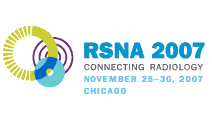
Abstract Archives of the RSNA, 2007
SSM19-05
Assessment of a Fast MRI Method for Human Liver Fat Quantification by Multi-Voxel MR Spectroscopy
Scientific Papers
Presented on November 28, 2007
Presented as part of SSM19: Physics (MRI and MRIS—Novel Methods)
Paul Eduard Sijens PhD, Presenter: Nothing to Disclose
Roy Irwan, Abstract Co-Author: Nothing to Disclose
Mireille A. Edens, Abstract Co-Author: Nothing to Disclose
Ronald P. Stolk, Abstract Co-Author: Nothing to Disclose
Matthys Oudkerk MD, PhD, Abstract Co-Author: Nothing to Disclose
Non-alcoholic fatty liver disease is an early marker of cardiovascular disease and volunteer studies are important to extent the knowledge of risk factors.
A recent Dixon-based MRI method for quantifying liver fat content using dual-echo breath-hold gradient echo imaging was validated by phantom experiments and compared with results of biopsy in two patients [Radiology 2005;237:1048-1055]. We applied this fast method in ten healthy volunteers and compared the outcomes with the results of MRS, the gold standard in quantifying liver fat content.
Studies were conducted at 1.5T on 10 healthy males (22–58 years) with Body Mass Indexes ranging from 20 to 33. For MRI (dual-echo breath-hold gradient echo imaging, out of phase and in phase using flip angles of 70º and 20º) and MRS (non-water suppressed chemical shift imaging) a large flex coil placed over the liver was used simultaneously with the spine array coil as receiver. Liver fat quantifications were conducted on 5x8x4 cm3 liver volume subdivided into 7 MRI slices /32 MRS voxels.
Compared with MRS, liver fat content according to MRI was too high in nine subjects (range 3.3-10.7% vs. 0.9-7.7%) and correct in one (21.1 vs. 21.3%). Also, in one of ten subjects the fat content according to the MRI method was incorrect due to a (100-x) versus x percent lipid content mix-up. A minor adjustment of the MRI algorithm fixed this problem. Despite systematic overestimation of liver fat contents by MRI, Spearman's correlation between the adjusted MRI liver fat contents with MRS was high (r = 0.927, P < 0.001).
A recent phantom-validated Dixon-based MRI method designed for the assessment of high liver fat contents was evaluated on human subjects. Even after correction of the algorithm, a problem remaining with the Dixon-based method is that, at the lower end range, liver fat contents are systematically overestimated. Further studies on larger study populations are needed to assess the validity of this method in a broader range of liver fat content.
An advantage in clinical practice of being able to use the improved MRI method rather than multiple voxel MRS would be that the MRI method is faster (5 min vs. 21 min).
Sijens, P,
Irwan, R,
Edens, M,
Stolk, R,
Oudkerk, M,
Assessment of a Fast MRI Method for Human Liver Fat Quantification by Multi-Voxel MR Spectroscopy. Radiological Society of North America 2007 Scientific Assembly and Annual Meeting, November 25 - November 30, 2007 ,Chicago IL.
http://archive.rsna.org/2007/5008987.html

